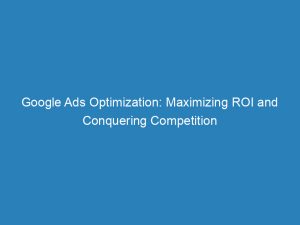- google ads optimization
- 1. Optimization Score In Google Ads
- 2. Recommendations For Campaign Optimization
- 3. Calculation Of Real-Time Optimization Score
- 4. Focus Areas For Optimization Score
- 5. Improving Campaign Performance With Negative Keywords
- 6. Adjusting Negative Keyword List With Search Terms Report
- 7. Utilizing Data From Google Analytics And Search Console
- 8. Optimization Of Responsive Search Ads
- 9. Maximizing Ad Effectiveness With Varied Headlines And Descriptions
- 10. Strategies For Bid, Budget, And Conversion Optimization
In the vast online world, where businesses strive to stand out and reach their target audience, one name reigns supreme: GoogleAds. This powerful advertising tool holds the key to unlock the door of success for countless businesses.
But how can one navigate through the sea of competition and maximize the potential of their GoogleAds campaign? Enter the GoogleAds optimization score – your secret weapon to achieve advertising greatness.
This score unlocks insights into the efficiency and effectiveness of your account setup, providing valuable recommendations to boost conversions and reach the right audience. Join us as we dive into the world of Google Ads optimization, uncovering the strategies and techniques that will skyrocket your online presence.
| Item | Details |
|---|---|
| Topic | Google Ads Optimization: Maximizing ROI and Conquering Competition |
| Category | Ads |
| Key takeaway | In the vast online world, where businesses strive to stand out and reach their target audience, one name reigns supreme: Google Ads. |
| Last updated | December 27, 2025 |
google-ads-optimization">google ads optimization
Google Ads optimization refers to the process of improving the performance and effectiveness of campaigns running on the platform. The optimization score, ranging from 0-100%, serves as a measure of how well an account is set up.
This score is calculated in real-time based on account statistics, settings, and recommendations provided by Google. Optimization efforts can focus on various areas such as conversions, impression share, clicks, and more.
One of the key ways to optimize campaigns is through the use of negative keywords, which help exclude irrelevant search queries. The search terms report allows for adjustments to the negative keyword list by providing insights into the actual search terms that triggered ads.
Additionally, leveraging data from Google Analytics and Search Console can help identify effective keywords. Responsive search ads require optimization through the use of many headlines and descriptions to avoid repetition and improve performance.
Location target bid adjustments allow for bid optimization based on user location. Aiming to maintain an optimization score of 100% is important for expected campaign performance.
Updated for the new year’s advertising best practices.
Demographics targeting and audience targeting can further enhance campaign optimization by excluding or adjusting bids based on specific demographics, interests, behaviors, and customer data. Bid optimization should align with business goals and utilize smart bidding strategies.
Proper budget allocation and optimization are critical, and the Waterfall methodology can be used to allocate the budget to the best-performing campaigns. Conversion tracking with appropriate settings is essential to measure cost per acquisition (CPA) and optimize for conversions.
An organized campaign and ad group structure should be maintained to ensure optimal performance. Starting with a single campaign and gradually increasing the budget while optimizing is recommended.
Lastly, remarketing campaigns can be highly effective in generating conversions at a lower cost. Overall, thorough optimization across various aspects of Google Ads is crucial to maximize campaign performance and achieve desired results.Key Points:
- Google Ads optimization improves campaign performance and effectiveness.
- The optimization score measures how well an account is set up.
- Optimization can focus on conversions, impression share, clicks, and more.
- Negative keywords exclude irrelevant search queries.
- Data from Google Analytics and Search Console can identify effective keywords.
- Demographics and audience targeting enhance campaign optimization.
Sources
https://www.reliablesoft.net/google-ads-optimization/
https://support.google.com/google-ads/answer/9061546?hl=en
https://agencyanalytics.com/blog/google-ads-optimization-checklist
https://localiq.com/blog/google-ads-optimization-tips/
Check this out:
💡 Pro Tips:
1. Use ad extensions to enhance your Google Ads campaigns. Ad extensions provide additional information and can improve ad visibility and click-through rates.
2. Utilize ad scheduling to display your ads during peak times or when your target audience is most likely to be searching.
3. Experiment with different bidding strategies to find the most effective one for your campaign. Google Ads offers various options such as cost-per-click (CPC), cost-per-acquisition (CPA), and return on ad spend (ROAS).
4. Regularly review and analyze your campaign data to identify areas for improvement. Look for keywords, ad copy, and landing pages that are underperforming and make necessary adjustments.
5. Test different ad formats and designs to see what resonates best with your target audience. This can include text ads, image ads, and video ads.
1. Optimization Score In Google Ads
Google Ads optimization is crucial for maximizing the return on investment (ROI) and conquering competition in the digital advertising space. One of the key metrics that advertisers need to focus on is the optimization score, which ranges from 0-100%.
This score represents how well an account is set up and provides valuable insights into areas that require improvement.
2. Recommendations For Campaign Optimization
To optimize campaigns effectively, Google Ads provides recommendations based on the optimization score. These recommendations are tailored to the specific account and can include suggestions for improving keywords, ad copy, bids, and budget allocation.
By implementing these recommendations, advertisers can enhance campaign performance and achieve better results.
3. Calculation Of Real-Time Optimization Score
The optimization score is calculated in real-time using a combination of account statistics, settings, and recommendations. Google Ads takes into account factors such as the relevance and quality of keywords, ad copy, landing pages, and the historical performance of the account.
This real-time calculation ensures that advertisers always have the most accurate representation of their account’s optimization level.
4. Focus Areas For Optimization Score
The optimization score can focus on various aspects of campaign performance, depending on the advertiser’s goals. These focus areas may include conversions, impression share, clicks, or other key performance indicators.
By aligning the optimization score with specific objectives, advertisers can prioritize their efforts and make informed decisions to optimize their campaigns effectively.
5. Improving Campaign Performance With Negative Keywords
One powerful way to improve campaign performance is by utilizing negative keywords. Negative keywords allow advertisers to exclude irrelevant search queries that might trigger their ads.
By excluding these irrelevant queries, advertisers can ensure that their ads are shown to a relevant audience, leading to higher click-through rates and better conversion rates.
6. Adjusting Negative Keyword List With Search Terms Report
The Search Terms report in Google Ads provides valuable insights into the actual search terms that triggered ads. By analyzing this report, advertisers can identify new negative keywords to add to their list and optimize their campaigns further.
This iterative process allows for continuous refinement and ensures that campaigns are consistently optimized for better performance.
7. Utilizing Data From Google Analytics And Search Console
Data from Google Analytics and Search Console can be immensely helpful in identifying effective keywords and optimizing campaigns. By analyzing user behavior, conversion rates, and other metrics in Google Analytics, advertisers can identify high-value keywords and adjust their bidding strategies accordingly.
Additionally, Search Console data can provide insights into organic search performance, enabling advertisers to expand their keyword targeting and improve overall campaign performance.
8. Optimization Of Responsive Search Ads
Responsive search ads require careful optimization and constant monitoring. These ads automatically adjust their format to fit different ad spaces, making them highly versatile.
To optimize responsive search ads, advertisers should provide multiple headlines and descriptions to allow for variation and avoid repetitiveness. By differentiating the text, advertisers can increase the likelihood of capturing the attention of their target audience and drive higher engagement.
9. Maximizing Ad Effectiveness With Varied Headlines And Descriptions
In addition to responsive search ads, it is important to maximize the effectiveness of all ad formats. By providing varied headlines and descriptions in ads, advertisers can cater to different user preferences and increase the chances of capturing their attention.
Differentiation in ad text also helps to avoid ad fatigue and ensures that the messaging remains fresh and engaging.
10. Strategies For Bid, Budget, And Conversion Optimization
Optimizing bids, budgets, and conversions is essential for achieving the desired ROI. Advertisers should align their bidding strategies with business goals and leverage smart bidding strategies provided by Google Ads.
It is crucial to set appropriate budget allocations and utilize budget optimization techniques, such as the Waterfall methodology, to allocate the budget to the best-performing campaigns. Conversion tracking should also be enabled with appropriate settings to measure the cost per acquisition (CPA) and optimize campaigns for conversions.
In conclusion, careful and continuous optimization of Google Ads campaigns is key to maximizing ROI and conquering competition. By understanding and utilizing the optimization score, implementing the recommended actions, and leveraging various optimization techniques, advertisers can drive better performance, reach their target audience effectively, and achieve their advertising goals.
Self-Serve DSP Platform • Buy Traffic • Programmatic Advertising











